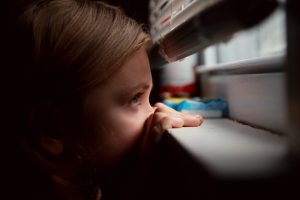As we continue to navigate this world during a pandemic and adjust to changing rules and mandates, children and adolescents may be the hardest hit group of all. Data is already emerging that shows the detrimental impact of the pandemic on children’s mental health. The pandemic, and its ensuing consequences, will likely have long-term negative effects, possibly altering an entire generation’s mental health and way of life permanently.
 Children and adolescents have experienced increased stress every day during the pandemic. Fear of the virus, personal illness, familial illness, loss, increased poverty, social isolation, and lockdown restrictions have increased fear, loneliness, anxiety, depression, and suicidal thoughts/attempts.
Children and adolescents have experienced increased stress every day during the pandemic. Fear of the virus, personal illness, familial illness, loss, increased poverty, social isolation, and lockdown restrictions have increased fear, loneliness, anxiety, depression, and suicidal thoughts/attempts.
The long-term effects of the pandemic on children and adolescents may more negatively impact high-risk groups such as those with mental health or preexisting health conditions, learning difficulties, developmental delays, and those living in poverty or with an adult who is quarantined and infected by COVID-19.
Common Changes in Mental Health
Data shows the most widespread and prevalent changes in mental health in children and adolescents during the pandemic include the following:
- Increased depression
- Increased loneliness
- Increased anxiety and worry
- Increased clinginess
- Decreased physical health
- Decreased sleep
- New PTSD symptoms
- New panic episodes
- Increased suicidality (thoughts and attempts)
- Increased hopelessness
- Increased moodiness
- Increased fear
While studies are ongoing, several surveys have shown quantifiable changes to children’s and adolescent’s mental health during the pandemic. According to a recent parent survey conducted in Spain and Italy – which included 1,143 parents of children and adolescents ages 3-18 – 85.7% of parents reported the following perceived emotional and behavioral changes in their children and adolescents during the lockdown: difficulty concentrating (76.6%), boredom (52%), irritability (39%), restlessness (38.8%), nervousness (38%), loneliness (31.3%), uneasiness (30.4%), and worry (30.1%).
Social Isolation and Loneliness
Social isolation and loneliness appear to be the greatest consequences of this pandemic and a predictor of future depression in children and adolescents up to nine years from now. Research shows that the duration of the loneliness, and not the intensity, increased symptoms of poor mental health. Children and adolescents have been forced to adjust to distance learning, physical absence from friends and teachers, and have had a significant decrease in daily in-person socialization.
 Schools supply socialization and identity through peer groups that cannot be replicated via social media or virtual platforms. Schools also supply a safe place for many children and adolescents whose homes may not feel safe or supportive. This sense of community, belonging, and safety was taken away from children and adolescents overnight.
Schools supply socialization and identity through peer groups that cannot be replicated via social media or virtual platforms. Schools also supply a safe place for many children and adolescents whose homes may not feel safe or supportive. This sense of community, belonging, and safety was taken away from children and adolescents overnight.
In addition, they have also been kept away from extended family and other significant people who contribute to healthy development and connection. Every aspect of normal life has been altered. Extracurricular activities and community programs children and adolescents rely on have all but stopped or look vastly different. The physical togetherness that has been woven into their everyday lives since birth has virtually disappeared.
The forced isolation due to COVID-19 has also increased PTSD (post-traumatic stress disorder) symptoms in children and adolescents that manifest as anxiety and fear of the illness, clinginess, irritability, and distractibility. Specifically, social anxiety is on the rise. Children and adolescents have reported a sense of missing out and a fear of rejection, exclusion, and potential loss of status among peer groups due to the loss of in-person connection.
How Adults’ Mental Health Affects Children’s Mental Health
It is important to also address the impact that this pandemic has had on the adults and caretakers. Adults have not escaped this pandemic unscathed. Just like children and adolescents, adults battle increased fear, depression, anxiety, isolation, loneliness, unemployment, grief, increased responsibilities and stress, and possible illness.
Just as children and adolescents had an almost overnight out-of-nowhere change to their daily lives, so did adults. Parents and caretakers have the added stress of ensuring that their children’s mental health is strong and stable. This is difficult when one’s own mental health is suffering.
Children look to parents and caretakers as models of how to react to stress and change and will pattern their responses after yours. When your coping skills are depleted and negatively reactive your child or adolescent will absorb your emotions and mimic your reactions. Seeking help is vital during this time of change and daily unknowns. It is important to work with a professional to alleviate your fears, anxiety, and depression to better improve your mental health and that of your child.
How to Support Your Child or Adolescent
Children and adolescents look to the adults in their lives to stabilize and normalize a stressful life situation. Does this mean you cannot be affected by the pandemic? On the contrary, it is important that you speak honestly with your children and adolescents about your own feelings and honestly address the reality of this current world.

Keep in mind the developmental age and stage of your child or adolescent as your stress can increase theirs and increase their fears and insecurities. Make sure to provide developmentally appropriate responses to their questions and be careful not to minimize their feelings. It is often easy to think children and adolescents will “get over it” or do not feel anything.
Your child or adolescent has complex feelings like you and needs understanding and support. They will often internalize their feelings due to fear, insecurity, inability to express or articulate their emotions, or because they do not feel they have a safe place to share their feelings.
It is important to be aware of any changes in behavior or moods that seem to correlate with the pandemic. As suicidality – serious suicidal thoughts, plans, and attempts – has increased, it is important to look for signs in your child or adolescent that he or she is having thoughts of suicide. Suicidality is most often associated with signs of depression and can be subtle in children.
Some of these signs and symptoms will most likely be chronic and not a one-time event. The following changes may indicate increased depression and risk of suicidality (Psycom):
- Sleep habits (increased or decreased sleep, insomnia, or night terrors)
- Eating habits (increased, decreased, or cessation of appetite)
- Socially withdrawing from friends and family (by choice)
- Physical symptoms that cannot be explained
- Decreased academic performance
- Missing classes (especially online classes)
- Loss of interest in daily activities
- Hyper focus on and preoccupation with death
- Statements about dying
- Suddenly giving away toys or items of importance
- Increased hopelessness
- Writing about or drawing images of death
- Previous suicide attempt(s)
- New behavior that seems odd and unlike their normal behavior
 All signs of suicidality need to be taken seriously and assessed by a mental health professional. It is also important to ask your child if they have thoughts about suicide, have a plan and/or means, and if they are experiencing depression.
All signs of suicidality need to be taken seriously and assessed by a mental health professional. It is also important to ask your child if they have thoughts about suicide, have a plan and/or means, and if they are experiencing depression.
This pandemic has likely brought many disappointments, changes, and pain to your child or adolescent. Creating a daily routine and structure for your child or adolescent can help minimize stress and anxiety. This is an excellent opportunity to offer lessons in life skills (i.e., contributing to household chores, helping with siblings, cooking, learning about finances, etc.).
It is also crucial to teach your child or adolescent how to effectively handle change and how to cope effectively. Modeling and encouraging proper sleep habits, physical activity, and healthy eating habits can also alleviate negative symptoms.
Lastly, decreasing your child’s screen time, increasing his or her social responsibility, encouraging peer relationships, and caring for your own needs will greatly improve the negative effects of this pandemic and potentially prevent children’s mental health issues in the future.
Though this pandemic has taken a toll on children’s mental health, surveys also show that the widespread social distancing has diminished some anxiety and depression, especially for some adolescents. Knowing everyone is subjected to the same pandemic and mandates may improve levels of anxiety and depression and decrease feelings of isolation and exclusion.
Seeking Help for Your Child or Adolescent
If you believe your child or adolescent needs additional support during and after this pandemic, it is important to seek the help of a mental health professional. At Seattle Christian Counseling, a trained counselor can help your child or adolescent navigate this time of isolation and change.
A Christian counselor can offer support, care, acceptance, and education about positive coping and life skills. During this vulnerable time and always, we have hope in a good and gracious God who is sovereign and in control. He will bring good from this pandemic and be glorified. There is hope for your child or adolescent.
Therefore, we do not lose heart. Even though our outward man is perishing, yet the inward man is being renewed day by day. For our light affliction, which is but for a moment, is working for us a far more exceeding and eternal weight of glory, while we do not look at the things which are seen, but at the things which are not seen. For the things which are seen are temporary, but the things which are not seen are eternal. – 2 Corinthians 4:16-18
Resources:
Rapid Systematic Review: The Impact of Social Isolation and Loneliness on the Mental Health of Children and Adolescents in the Context of COVID-19 (nih.gov)
Impact of COVID-19 and lockdown on mental health of children and adolescents: A narrative review with recommendations (nih.gov)
Children and Suicide: What are The Warning Signs? (psycom.net)
PsyArXiv Preprints | Immediate psychological effects of the COVID-19 quarantine in youth from Italy and Spain
“Peeking Out the Window”, Courtesy of Sharon McCutcheon, Unsplash.com, CC0 License; “Masked Boy”, Courtesy of Banaez, Unsplash.com, CC0 License; “Empty Classroom”, Courtesy of MChe Lee, Unsplash.com, CC0 License; “The World is Temporarily Closed”, Courtesy of Edwin Hooper, Unsplash.com, CC0 License


